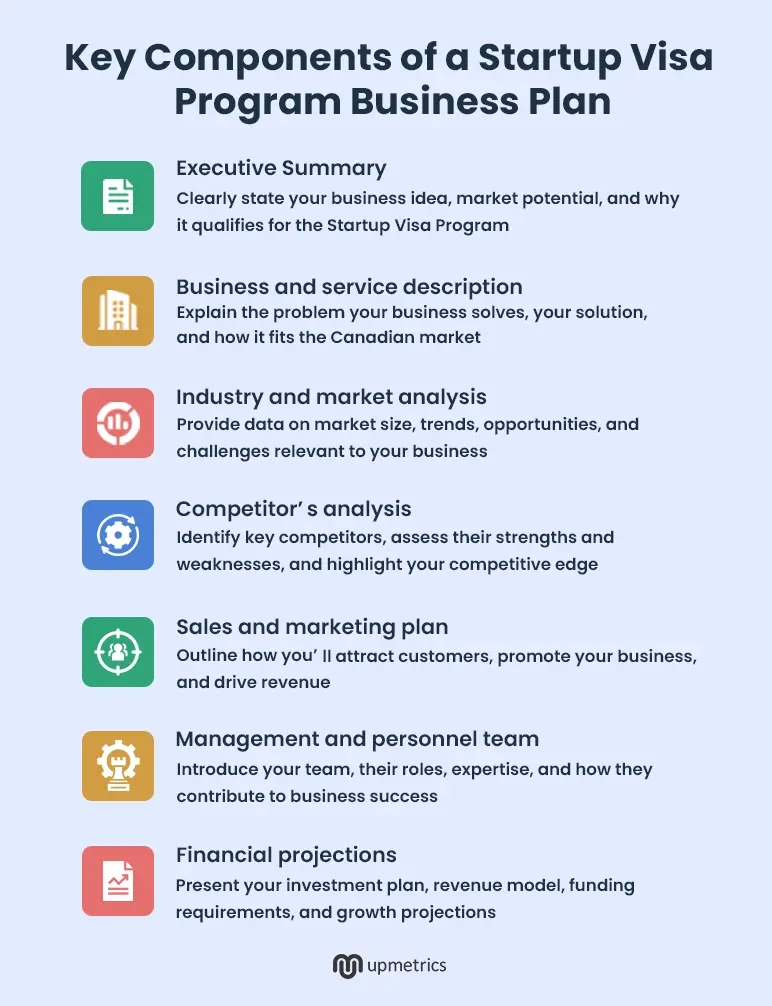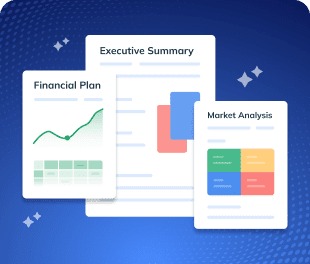Starting a business in Canada’s stable and growing economy is an exciting opportunity.
But where do you start? Funding, compliance, and market entry can feel overwhelming, especially as a foreign entrepreneur.
That’s where the Startup Visa (SUV) Program comes in. This government-backed program provides a structured pathway to help you launch and grow your business in Canada while securing permanent residency.
As part of the program requirements, you must submit a detailed business plan demonstrating your startup’s viability, innovation, and potential for growth.
In this blog post, we’ll walk you through a step-by-step guide to help you create a strong business plan for the Start-Up Visa Program.
What is Canada’s startup visa business plan?
A Canada Startup Visa Business Plan is a crucial document entrepreneurs require when applying to the Start-Up Visa (SUV) Program. More specifically, it’s a document that will help you get a letter of support from a designated organization—an aspect necessary to complete your application.
Such business plans demonstrate the viability of the proposed business, highlighting how it’s innovative, scalable, and capable of creating jobs in Canada.
About Startup Visa Program Canada
Canada’s Start-Up Visa (SUV) Program is a government initiative that allows immigrant entrepreneurs to build and grow businesses in Canada (outside Quebec). It’s designed for those with innovative business ideas that have the potential to create jobs in Canada and compete globally.
The program prioritizes businesses in key sectors such as agri-food, clean technology, advanced manufacturing, ICT & digital services, and biotechnology. However, any business idea that can benefit Canada’s value, ecosystem, and economy as a whole can apply to the SUV program.
Why do you need a business plan for the Startup Visa Program?
While a business plan is preferable (not compulsory) for your SUV program application, it’s mandatory to have a letter of support from one of the designated organizations (check the list here) recognized by the Canadian government.
Now, each of these designated organizations can only support up to 10 applications each year. Meaning, that there’s intense competition, in getting one of these organizations to back your business idea.
This is where a well-crafted business plan becomes necessary.
It helps the designated organization see your business’s value, viability, and potential for success in the Canadian market. It also allows them to evaluate how well your business aligns with Canada’s economic priorities and its ability to compete on a global scale.
A business plan alone will influence the organization’s decision to back you or not. Simply put, only a strong business plan can help you secure a letter of support, without which you can’t complete your SUV program application.
What to include in your Canada’s Startup Visa Program business plan?
Now comes the most important aspect: What exactly should you include in your SUV business plan?
Well, it’s more or less similar to what you include in your regular business plans, but with a stronger emphasis on innovation, scalability, and job creation in Canada. Your plan should focus on convincing a designated organization that your business is worth backing.
Here are the key components to include in your StartUp Visa program business plan:

1. Executive summary
This is the very first section of your business plan that will offer a quick high-level overview of your entire business plan.
Here you’ll specifically highlight the following aspects:
- Business concept: Crisply explain what your business does and highlight how that shall be beneficial to the Canadian market
- Innovative edge: Outline how your business stands apart, i.e. in terms of clean technology, sustainability, or filling the demand that Canadian markets are lacking
- Scalability & market Potential: Demonstrate how your business can grow, expand internationally, and generate economic benefits for Canada
- Business objectives: As you list down your objectives, make sure that you highlight specific benefits your business will bring to Canada’s economy
- Key financials: Offer a quick overview of your funding demand, profitability, and projected revenue/ sales in the first year
- Job creation & economic contribution: Explain how your business will create employment opportunities in Canada
Remember, it’s an overview that should stand alone. Meaning, it should offer sufficient context about your business without making it feel incomplete.
However, this section has to be concise, say no more than 2 pages.
2. Business and service description
In this section, you briefly explain the opportunity or problem your business would be leveraging. It’s very important that the problem you choose is specific to the Canadian market and your target demographics. Alongside the problem, also explain the solution you have to offer.
For instance, cities like Toronto are facing daycare shortages, creating a demand for better childcare solutions. Addressing such challenges with relevant data points will add substance and relevance to your business plan.
However, the key here (in fact throughout the entire document) is to explain everything very simply without bringing in complex jargon or technical language.
In this section, you also highlight:
- Business model: Explain how your startup will generate revenue and sustain operations
- Milestones and planned action: Highlight the short-term and long-term milestones (you’ve planned) and a realistic plan to achieve them
- Mission & vision: Clearly state what your business aspires to be and how it aims to grow and contribute to Canada’s economy in the long run
- Canadian business environment: Highlight how your business fits into Canada’s market, aligns with industry trends, and meets local demand while complying with regulations and economic priorities
- Target clients: Define your ideal customers, their needs, and how your product or service solves their problems, ensuring a strong fit within the Canadian market
3. Industry and market analysis
This section of your SUV business plan offers an in-depth and accurate overview of your marketplace.
Start with a broad macro overview and narrow it down to your specific niche with specific data points.
Now, most applicants make the mistake of only relying on secondary data to build assumptions of demand, product, market need, and customer pain points. And while Google and industry publications can help you validate the preliminary assumptions, they aren’t enough to build a strong case.
To strengthen your market analysis, include primary research such as customer surveys, expert interviews, or pilot study results. These real-world insights would give designated organizations confidence that your business has actual demand in Canada.
Now, you may include detailed research materials, thesis, and assumptions in the appendix, but for this section clearly outline:
- Market size: Provide data on the total addressable market in Canada, showing the potential reach and scalability of your business
- Market trends: Highlight key industry shifts, technological advancements, or consumer behaviors that create demand for your product or service
- Growth opportunities: Identify areas where your business can expand, whether through new customer segments, geographic markets, or innovative offerings
- Entry barriers: Outline potential challenges such as competition, capital requirements, or industry restrictions, and explain how your business will overcome them
- Regulatory requirements: Detail any licenses, compliance standards, or legal considerations needed to operate in Canada
Add as many graphs, charts, visuals, and tables as you can in this section. It will not only break text monotony but will also make the information easy to comprehend.
4. Competitor’s analysis
Your business is likely to be affected by a couple of direct and indirect competitors. In this section you acknowledge them, assess their strengths and weaknesses, and outline your competitive edge.
Study the market up close and find the businesses and enterprises offering similar products/services or catering to a similar audience as yours.
Evaluate each competitor based on their pricing, USPs, weaknesses, target audience, market share, and any relevant data point that highlights their market position.
Further, build a SWOT analysis or use Porter’s five forces model to point out your competitive advantage over other market players.
The competitive analysis section should be your attempt to demonstrate why your startup deserves support over existing market players and how it aligns with Canada’s economic priorities and innovation-driven business landscape.
5. Sales and marketing plan
The sales and marketing section of your SUV business plan demonstrates how you plan to acquire customers and sell your services to them.
It should clearly define your customer acquisition strategy, your plan to position your brand in the market, and the tactics you’ll use to drive sales and sustain growth in Canada.
Additionally, outline the marketing channels you’ll be exploring. Lay out a clear marketing plan, at least, for the initial months to boost visibility and awareness in your target market.
If you’ve your website ready, embed it in this section for the readers. Further, all your marketing materials, logos, and branding leaflets can be added to the appendix.
This section should demonstrate your understanding of the Canadian market when it comes to marketing and sales.
6. Management and personnel team
In the management section, you will introduce yourself and your partners (if any). Outline everyone’s roles, qualifications, work experience, and skill sets that will help launch and grow your very specific business. Also, highlight the voting and ownership rights of each partner.
Additionally, offers a detailed overview of the team structure, including current and future hiring plans. Identify key positions needed for business operations, growth, and compliance with Canadian labor standards. If applicable, outline the timeline for recruitment and how these roles will contribute to the company’s success.
7. Financial projections
In the financial projections section, you will offer a comprehensive overview of business finances, outlining very specifically:
- Investment plan: Detail how much capital is required, where it will be allocated, and how it will drive business growth
- Funding requirement: How will you fund your business, i.e. personal investment, venture capital, angel investors, or support from a designated organization
- Realistic Projections: Provide sales, cash flow, income, and expense forecasts for the next 3-5 years, backed by market data and realistic growth assumptions.
- Break-Even Analysis: Highlight the point at which your business is expected to cover its costs and start generating profit.
- Operating Costs: Identify fixed and variable costs, such as rent, salaries, technology, and production expenses, to ensure financial clarity.
Your market research will come in handy as you build assumptions for this section. The evaluating party will catch the fluff and over-optimism in a jiffy. So make sure that you always ground your data in realistic assumptions.
With that, you have a business plan that’s perfectly structured for what the designated organizations will require.
Download Canada Start-Up Visa Business Plan Template
Ready to write your Business Plan? Refer to the outline in this blog post and download our tailored Start-Up Visa business plan PDF to create a strong, well-structured plan that can be submitted with your SUV application.
The Quickest Way to turn a Business Idea into a Business Plan
Fill-in-the-blanks and automatic financials make it easy.
Start writing your business plan
This blog post offered an in-depth overview of what Canada’s Startup Visa program business plan should include. However, crafting a strong plan from scratch isn’t always easy—many entrepreneurs struggle with a blank page syndrome.
Now, there’s no substitute for business and strategic planning. However, writing and structuring the plan? Well, that’s where things can get easier.
With an AI business plan generator, the focus isn’t just on writing—it’s about guiding you through the entire planning process. Like Upmetrics does. It streamlines research, structures key sections, and helps you create your SUV business plan in just a few hours. All, without the stress of starting from scratch.
Don’t wait too long to perfect every detail. Quickly build and submit your plan to your chosen designated organization and secure your letter of support.



